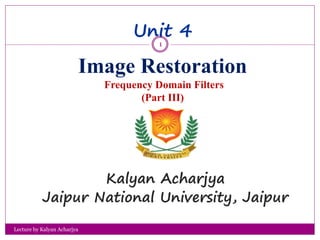
Image Restoration (Frequency Domain Filters):Basics
- 1. Unit 4 Image Restoration Frequency Domain Filters (Part III) Kalyan Acharjya Jaipur National University, Jaipur 1 Lecture by Kalyan Acharjya
- 2. Lecture by Kalyan Acharjya 2 Disclaimer All images/contents used in this presentation are copyright of original owner. This PPT is use for academic purpose only.
- 3. Filter Filter: A device or material for suppression or minimizing waves or oscillations of certain frequencies Frequency: The number of times that a periodic function repeats the same sequence of values during a unit variation of the independent variable. Filters are classified as (Frequency Domain): (1) Low-pass (2) High-pass (3) Band-pass (4) Band-stop ….many more 3 Lecture by Kalyan Acharjya
- 4. Filters Types Original signal Low-pass filtered High-pass filtered Band-pass filtered Band-stop filtered 4 Lecture by Kalyan Acharjya
- 5. Image Restoration? Objective: To restore a degraded/distorted image to its original content and quality. Spatial Domain: g(x,y)=h(x,y)*f(x,y)+ ŋ(x,y) Frequency Domain: G(u,v)=H(u,v)F(u,v)+ ŋ(u,v) Matrix: G=HF+ŋ Degradation Function h Restoration Filters g(x,y) f(x,y) ŋ(x,y) f(x,y) ^ Degradation Restoration 5 Lecture by Kalyan Acharjya
- 6. Low-Pass Filters (Smoothing filters) Preserve Low Frequencies-Useful For Noise Suppression Frequency Domain Time Domain Example: 6 Lecture by Kalyan Acharjya
- 7. High-Pass Filters (Sharpening Filters) Preserves High Frequencies - Useful for Edge Detection Frequency Domain Time Domain Example: 7 Lecture by Kalyan Acharjya
- 8. Band-Pass and Band Stop Filters Preserves Frequencies Within a Certain Band Frequency Domain Time Domain Example: Band Stop/ Reject 8 Lecture by Kalyan Acharjya
- 9. Lecture by Kalyan Acharjya 9 Correction: Before Integration 1/2pi
- 10. Image Processing and Fourier Transform Lecture by Kalyan Acharjya 10 Input Image Fourier Transform Do Operations Inverse Fourier Transform Fourier Transform: Inverse Fourier Transform
- 11. Fourier Transform Lecture by Kalyan Acharjya 11
- 12. Fourier Spectrum Lecture by Kalyan Acharjya 12 Percentage of image power enclosed in circles (Small to Large): 90, 95, 98, 99, 99.5, 99.9
- 13. Fourier Transform Lecture by Kalyan Acharjya 13 f(x,y) F(u,v) H(u,v)g(x,y) G(u,v)=F(u,v) • H(u,v)g(x,y) =f(x,y) * h(x,y)
- 14. Ideal Low Pass Filters Lecture by Kalyan Acharjya 14 u v H(u,v) 0 D0 1 D(u,v) H(u,v) H(u,v) = 1 D(u,v) D0 0 D(u,v) > D0 D(u,v) = u2 + v2 D0 = cut off frequency
- 15. Blurring-Ideal Low Pass Filter 98.65% 99.37% 99.7% 15Lecture by Kalyan Acharjya
- 16. Image Sharpening - High Pass Filter H(u,v) - Ideal Filter H(u,v) = 0 D(u,v) D0 1 D(u,v) > D0 D(u,v) = u2 + v2 D0 = cut off frequency 0 D0 1 D(u,v) H(u,v) u v H(u,v) 16Lecture by Kalyan Acharjya
- 17. H(u,v) D(u,v)0 D0 1 D(u,v) = u2 + v2 High Pass Gaussian Filter u v H(u,v) H(u,v) = 1 - e -D2(u,v)/(2D2 0) e/11 17Lecture by Kalyan Acharjya
- 18. High Pass Filtering - Example Original High pass Emphasis High Frequency Emphasis + Histogram Equalization 18Lecture by Kalyan Acharjya
- 19. Band Pass Filtering H(u,v) = 1 D0- D(u,v) D0 + 0 D(u,v) > D0 + D(u,v) = u2 + v2 D0 = cut off frequency u v H(u,v) 0 1 D(u,v) H(u,v) D0- w 2 D0+ w 2D0 0 D(u,v) D0 -w 2 w 2 w 2 w 2 w = band width 19Lecture by Kalyan Acharjya
- 20. Band Reject Filters Removing periodic noise form an image involves removing a particular range of frequencies from that image. Band reject filters can be used for this purpose. An ideal band reject filter is given as follows: 2 ),(1 2 ),( 2 0 2 ),(1 ),( 0 00 0 W DvuDif W DvuD W Dif W DvuDif vuH 20 Lecture by Kalyan Acharjya
- 21. Band Reject Filters contd.. The ideal band reject filter is shown below, along with Butterworth and Gaussian versions of the filter. Ideal Band Reject Filter Butterworth Band Reject Filter (of order 1) Gaussian Band Reject Filter 21 Lecture by Kalyan Acharjya
- 22. Result of Band Reject Filter Fig: Corrupted by Sinusoidal Noise Fig: Fourier spectrum of Corrupted Image Fig: Butterworth Band Reject Filter Fig :Filtered image 22 Lecture by Kalyan Acharjya
- 23. Adaptive Filters 23 Lecture by Kalyan Acharjya
- 24. 24 Lecture by Kalyan Acharjya
- 25. Adaptive Median Filter 25 Lecture by Kalyan Acharjya
- 26. Algorithm Objectives: Remove salt and pepper (Impulse) noise Provide smoothing Reduce distortion, such as excessive thinning or thickening of object boundaries 26 Lecture by Kalyan Acharjya
- 27. Results 27 Lecture by Kalyan Acharjya
- 28. Band Pass Filters ),(1),( vuHvuH brbp 28 Lecture by Kalyan Acharjya
- 29. Notch Filter Lecture by Kalyan Acharjya 29 Are used to remove repetitive "Spectral" noise from an image. Are like a narrow High pass filter, but they "notch" out frequencies other than the dc component. Attenuate a selected frequency (and some of its neighbors) and leave other frequencies of the Fourier transform relatively unchanged.
- 30. Notch Filters Notch filters Ideal Notch Reject Filter otherwise1 Dv)(u,DorDv)(u,Dif0 ),( 0201 vuH 2/12 0 2 01 )2/()2/(),( vNvuMuvuD 2/12 0 2 02 )2/()2/(),( vNvuMuvuD 30 Lecture by Kalyan Acharjya
- 31. Notch Filters Butterworth Notch Reject Filter of order n Gaussian notch reject filter n vuDvuD D vuH ),(),( 1 1 ),( 21 2 0 2 0 21 ),(),( 2 1 1),( D vuDvuD evuH 31 Lecture by Kalyan Acharjya
- 32. 32 Lecture by Kalyan Acharjya
- 33. Notch Filter Result 33 Lecture by Kalyan Acharjya
- 34. Thank You! Any Question Please? kalyan5.blogspot.in 34Lecture by Kalyan Acharjya
